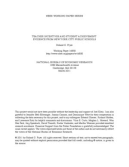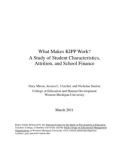By Lauren Rosenblum | Encino Patch | http://bit.ly/gX5vM5
Preuss works her way around the classroom to assist her students. Credit: Lauren Rosenblum
31 March 2011 | 1:30pm - Hesby Oaks School in Encino, which reopened as a kindergarten through eighth-grade school five years ago, faces the potential loss of nearly half its teaching staff next year as a result of the state’s budget crisis and its impact on the Los Angeles Unified School District.
Eight of the 18 teachers at Hesby Oaks received Reduction in Force notices from LAUSD officials this month, which means they could lose their jobs at the end of the school year.
“It’s like they’re starting in the classroom instead of starting at the top,” said Heather Thompson, who has a first-grade daughter at Hesby Oaks. “It’s very frustrating that the first thing they say they’re going to do to fix any budget crisis is fire teachers.”
Los Angeles Unified spent more than $24.3 million to remodel and reopen Hesby Oaks after it was closed for two decades. It’s become a neighborhood school where brothers and sisters walk their younger siblings to campus each day, and parents volunteer as crosswalk attendants during the morning and afternoon rush. The surrounding real estate has become very desirable as the school’s test scores have improved each year.
“This school is the little school that could," said first-grade teacher Jennifer Preuss, who received an RIF notice. "We have built a community here with parents, teachers and community partners. LAUSD is notorious for first taking from the hands of a child. We are their food for their brain, and you don’t take away their food for their brain.”
The Hesby Oaks teachers with RIF notices are:
Preuss; Kati Davis, second grade; Parisa Collier, third grade; Danny Pattison, fourth grade; Curtis Wynkoop, fifth grade; Jude Eaton, sixth grade; Chelsie Pearson, middle school English language arts; and Lesleigh Alchanati, librarian.
Hesby Oaks is one of many LAUSD schools struggling to adapt to severe budget cuts the district is making to deal with a projected $408 million deficit.
“LAUSD is shooting themselves in the foot,” said parent Alana Rubens, whose children are in first and fifth grade at Hesby.
Rubens fears the budget cuts will peel off some of the best principals and teachers, along with vocal parents who’d otherwise fight for system-wide improvement.
“So what’s going to happen again is you’re going to have middle-class flight from public schools, and they’re going to go back to private schools," Rubens said. "Some schools are going to get closed down again.”
Shari Ure, who has a first grader and a middle school student at Hesby Oaks, added: “The school board is supposed to be there to protect these kids, but they are there to protect their own political placements…There’s an 800-pound gorilla in the room and nobody wants to talk about it.”
LAUSD board member Steve Zimmer, whose district includes Hesby Oaks, voted against the proposed budget.
“I talk a lot about the need to organize and export what works, and Hesby is certainly an example of a school that works,” Zimmer told Encino Patch.
“One of the reasons I voted against the budget is that I knew it would destroy a school like Hesby," he said. "This budget is an immoral act against children and it violates their basic rights to public education whether it’s at Hesby Oaks [in Encino] or Hillcrest in South L.A. The cuts are draconian and they're criminal.”
LAUSD has issued more than 5,000 RIF notices based on seniority, although it is not expected that every employee who received one will lose his or her job.
If Gov. Jerry Brown’s proposed budget plan is not approved, layoffs are inevitable and at least five elementary school classes at Hesby Oaks will be split to combine two grade levels into one classroom.
“A lot of parents are concerned about classroom size, the ratio of teachers to students, and the lack of the ability of teachers to be able to handle such large classrooms,” said Hesby Oaks parent Allison Goodman. “You can’t expect one teacher to teach 25 to 30 kids without help and be effective when there’s all different abilities.”
The parents and teachers also argue that layoffs based on seniority rather than performance and experience further exacerbate the harm of these budget cuts.
“For my situation, specifically, it hurts,” Preuss said. “I am a veteran teacher. I’ve been doing this for 10 years and have more experience in multiple grade levels and learning abilities than most teachers have after 10 years because of my years in special ed.”
From 2002 to 2004 Preuss taught severely disabled students at Garden Grove Elementary School in Reseda while pursuing her regular education credential. She worked with students who had cerebral palsy, diabetes, blindness, seizures, brain tumors, mental retardation and even inverted genitalia.
Even though she was a paid, contracted teacher with the district, LAUSD gives her credit only for her years as an employee with Hesby Oaks, saying her start date was in 2006.
“As if none of those years counted with those children, whose lives I believe I changed. I taught mentally retarded children how to read!” Preuss said. “But LAUSD doesn’t acknowledge it, and so I have to go—as I did last year—and be completely humiliated to sit in a hearing with an administrative judge and basically beg for them to give me credit for my time with the district.”
Hesby’s teacher-librarian, Lesleigh Alchanati, has also received an RIF notice. She has both a teaching credential and a library services credential.
LAUSD's proposed budget only guarantees high schools a full-time librarian while dozens of middle and elementary schools could be forced to close library doors or scale back services.
Cutting access to the 8,000 books and 12 computers in the library at Hesby Oaks is a big concern for parents and educators. Hesby Oaks does not have funds to build a separate computer lab, so integrating technology into the elementary and middle school curriculum means the library’s dozen computers are on demand throughout the school day.
“I don’t know what our school is going to do,” said Alchanati, who has been teaching for 21 years. “According to [the education] code, you cannot have a volunteer replacing a credentialed teacher and you cannot have a library aide replacing a teacher-librarian.”
If Alchanati loses her job, Hesby Oaks will have to choose between spending its budget on library staff or other needs such as nurses, custodians or administrators.
Principal David Hirsch declined an interview with Encino Patch.
“He’s got the parents and the teachers all going, ‘fix it, fix it, fix it!’ when he’s not given the tools to fix it, fix, fix it,” said Thompson, who sits on the school’s site committee, which is made up of the principal, teachers, parents and staff that oversee how the budget is spent.
“I think his original budget is like $60,000 to maintain the school for a year, she said. “And to be honest, that’s not enough. I think he’s doing the best he can with what he’s got.”
Because Hesby Oaks does not serve a low-income community, the school does not qualify for Title One funds. As a result, it seeks financial support from parents for necessities such as teacher aides, art and music programs, science enrichment and a physical education teacher. The active Hesby Involved Parents fundraising group is on track to raise $100,000 to fund those programs this year.
In addition to fundraising, parents and teachers at Hesby Oaks are now volunteering to clean the classrooms because the district only subsidizes one custodian to clean the entire school.
“There’s never been a greater equalizer than this crisis. This is affecting every school everywhere,” Zimmer said.
“We’re being held hostage by a small group of Republicans, [who are] not from the city of Los Angeles, who won’t even give tax payers the right to vote on whether they wish to tax themselves. You would think that we were living in a different country. That’s how bad it is.”
Comments (1)
Lesleigh:
3:04pm on Thursday, March 31, 2011
LAUSD has not guaranteed a Teacher Librarian in any of the elementary, middle or high schools. This current year the district defunded the Teacher Librarian position at the middle schools and for the 2011-2012 year, they are proposing to defund the Teacher Librarian position at all the High Schools as well. The district went back to 1988 when issuing RIF notices for the Teacher Librarian.
Well staffed school libraries are proven to raise test scores, are a proven method of intervention, and supplement the arts that have been already cut from the budget. How can a school function without the information hub of the school open and appropriately staffed?
Hesby Oaks does not receive enough money in their budget to fund the teacher librarian position even if they wanted to. What happened to equal access for all?


 Gladwell's
Gladwell's 






